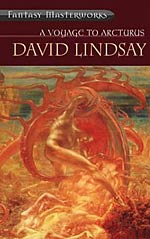
![]() davidpackwood1@gmail
davidpackwood1@gmail
7/6/2024
![]()
"He realized that he was on a foreign planet. But he was not stirred or uplifted by the knowledge; he was conscious only of moral ideas." (AVTA, 140).
Decades before Aldous Huxley wrote about the properties of hallucinogenic drugs, or Dick ground out his early mind-screw tales, an obscure Scottish author created the most trippy novel of the century. My first attempt to read this book ended in dismal failure; it was an English edition of the book on my 70s shelves, sold in the 90s, and replaced by this American version published in 1972, obtained from an Oxfam in Canterbury. After reading it years later, and thoroughly enjoying it, I'm not sure if I can write a review of this work that will capture its spirit, or accurately describe its ideas. The over-arching intellectual framework here is Gnosticism: Maskull, Nightspore and Krag - the names are brilliant- journey to the double-starred planet of Tormance via the "back-rays" of the light from these distant stars. On arrival, Maskull's companions disappear, and he is left to make a pilgrimage through the fantastic coloured lands, mountains and watercourses of the planet; he meets a large number of planet-dwellers who mostly perish, in their death throes taking on the expression of the deity Crystalman, who despite his pure-sounding name, represents what the Gnostics call "rex mundi" king of the world blocking mortals from the real divinity. Sorting out who represents evil and good is one of the core themes of this novel; some gentle beings can morally transform and kill. In fact, the body count is quite high, since nearly every creature that Maskull meets is killed- sometimes by him- before this bearded Everyman moves on to another encounter. Though Lindsay's style isn't particularly interesting, his invention is startling; anybody interested in the invention of xenobiological worlds will be held by this novel. Humanoid aliens possess appendages consisting of tentacles, extra eyes, and other parts which conveys their strangeness. Sexuality is bizarre too with some of Tormance's dwellers being hermaphroditic, both on the physiological and psychological levels. And remember, this novel was published about 50 years before those sexually ambivalent SF books of the 70s. So, Lindsay was a prophet of that evolution too. As I finished this book at lunchtime today, I literally felt my mind exploding as I tried to put the scene of Crystalman feeding off planetary souls into my head. I can honestly state that this is the weirdest book I've ever read. It will need to be re-read after I've researched the meaning of it. Unsurprisingly, Lindsay's book was a complete failure in 1920. What audience did he have in mind! Today, it has been praised by august literati such as C.S. Lewis, Michael Moorcock, even Harold Bloom who tried to pen a fantasy novel of his own as he is an adherent of Gnosticism. But nobody could imitate this book with its blue stars, green snow, its bewildering array of doomed characters, all overshadowed by matters of deep philosophy and theological struggle. A work of minor genius.